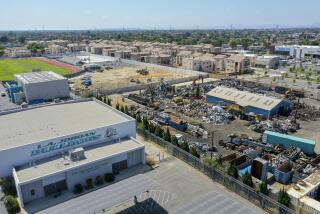Mistrial Declared in Rocketdyne Case
- Share via
A Riverside jury deadlocked Friday on whether two former Rocketdyne employees illegally burned chemical waste that resulted in a deadly 1994 blast at the Santa Susana Field Laboratory near Chatsworth.
After more than a week of deliberations, the jury of eight men and four women voted 10-2 in favor of guilty on three charges. But that was short of the unanimous verdict required for a criminal conviction.
The defendants, Joseph E. Flanagan, 61, of Stanwood, Wash., and Edgar R. Wilson, 65, of Chatsworth, are charged with violating federal environmental laws.
On Friday, U.S. District Court Judge Robert J. Timlin declared a mistrial and set a March 18 hearing. Assistant U.S. Atty. William Carter will have to decide whether to retry the case.
“No decision has been made at this point in time,” said Thom Mrozek, a spokesman for the U.S. attorney’s office.
Defense attorneys obviously wanted a verdict of not guilty, but said they were satisfied with a hung jury.
“Dr. Flanagan and I are pleased that after five years of investigation and a four-month trial ... the government could not convince 12 people of guilt on any of the charges,” said Flanagan’s attorney, John D. Vandevelde. “We are prepared to try this case repeatedly until Dr. Flanagan is fully exonerated.”
Leonard Sharenow, Wilson’s attorney, said his client maintains his innocence.
“We think that the government should just drop the case and not waste any more taxpayer money,” he said. Sharenow estimates the government has spend hundreds of thousands of dollars in its seven-year investigation and prosecution of the case.
Flanagan and Wilson are accused of illegally burning chemical waste at the field laboratory on July 21, 1994 and July 26, 1994.
Flanagan, then director of Rocketdyne’s Chemical Technology Group, also is charged with illegal waste storage.
Each count carries a maximum penalty of up to five years in prison and a $250,000 fine.
A third defendant, James F. Weber, 52, of Moorpark, pleaded guilty in August to illegally storing explosive materials, a misdemeanor. He has not yet been sentenced.
At trial, Carter argued the defendants knew they were burning waste. He said they followed a procedure similar to that used at the laboratory’s old burn pit.
They poured chemicals on top of sawdust in a large aluminum pan and ignited them, he said. They did not measure the ingredients, nor did they collect data.
The first burns took place on July 21, 1994. Five men, including Wilson and Weber, ignited the chemicals but had to stop when sparks created a nearby brush fire.
Five days later, the men met again and conducted two burns before the chemicals exploded. The blast killed scientists Otto K. Heiney, 53, of Canoga Park, and Larry A. Pugh, 51, of Thousand Oaks.
Flanagan was not present, but was the men’s supervisor.
Both Flanagan and Wilson testified that they believed the burns were legitimate scientific tests.
Flanagan said he did not direct, approve or plan any “phony testing” or illegal storage.
Wilson said he was told Flanagan had authorized using excess rocket propellants for overpressure tests. He admitted to once burning waste, but said he was reprimanded and never did it again.
A witness for the prosecution, Lee Wells, 70, of Newbury Park, was severely burned in the explosion and was granted immunity to testify against the defendants. He said he assumed that they were burning hazardous waste.
Heiney’s widow, Judy, also testified for the prosecution. She said her husband confided his growing frustration with “stupid environmental rules” and how the lab could “get around” them. She said her husband would not have acted without Flanagan’s approval.
For the same incidents, Rocketdyne’s then parent company, Rockwell International Corp., pleaded guilty in 1996 to mishandling hazardous chemicals and paid a $6.5-million fine.
More to Read
Sign up for Essential California
The most important California stories and recommendations in your inbox every morning.
You may occasionally receive promotional content from the Los Angeles Times.










